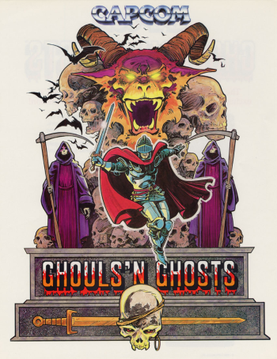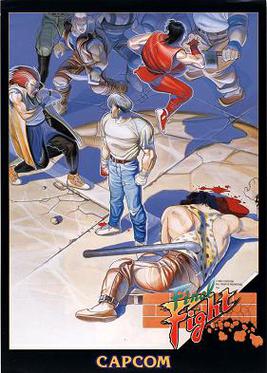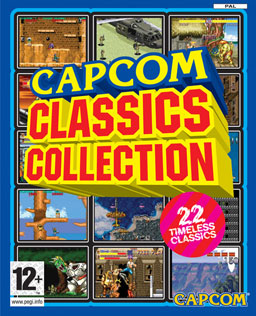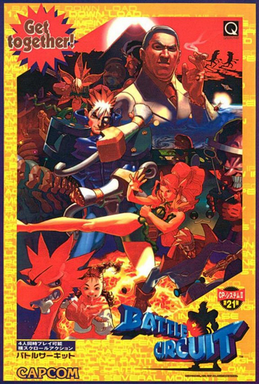
Ghouls 'n Ghosts, known as Dai Makaimura in Japan, is a side-scrolling platform game developed by Capcom, released as an arcade video game in 1988 and ported to home platforms. It is the sequel to Ghosts 'n Goblins and the second game in the Ghosts 'n Goblins series.

Columns is a match-three puzzle video game released by Jay Geertsen in 1989. Designed for the 68000-based HP 9000 running HP-UX, it was ported to Mac and DOS before being released commercially by Sega who ported it to arcades and then to several Sega consoles. The game was subsequently ported to other home computer platforms, including the Atari ST.

Street Fighter II: The World Warrior is a 2D fighting game developed by Capcom and originally released for arcades in 1991. It is the second installment in the Street Fighter series and the sequel to 1987's Street Fighter. It is Capcom's fourteenth game to use the CP System arcade system board. Street Fighter II vastly improved many of the concepts introduced in the first game, including the use of special command-based moves, a combo system, a six-button configuration, and a wider selection of playable characters, each with a unique fighting style.

Final Fight is a side-scrolling beat-'em-up video game produced by Capcom. Originally released as an arcade game in 1989, it was the seventh title released for the CP System hardware. Set in the fictional Metro City, the game lets the player control one of three street fighters: former pro wrestler and city mayor Mike Haggar, expert brawler Cody Travers, and modern-day ninja Guy. The trio set out to rescue Jessica when she is kidnapped by the Mad Gear Gang.

Super Street Fighter II: The New Challengers is a competitive fighting game produced by Capcom and originally released as an arcade game in 1993. It is the fourth game in the Street Fighter II sub-series of Street Fighter games, following Street Fighter II: Hyper Fighting. It refines and balances the existing character roster from the previous versions, and introduces four new characters. It is the first game on Capcom's CP System II hardware, with more sophisticated graphics and audio over the original CP System hardware used in previous versions of Street Fighter II.

The CP System is an arcade system board developed by Capcom that ran game software stored on removable daughterboards. More than two dozen arcade titles were released for CPS-1, before Capcom shifted game development over to its successor, the CP System II.

U.N. Squadron is a 1989 side-scrolling shooting game released by Capcom for the CPS arcade hardware and for the Super Nintendo Entertainment System. The game was released in Japan as Area 88, and is based on the manga series of the same name, featuring the same main characters. Their mission is to stop a terrorist group known as Project 4. It was followed by a spiritual successor Carrier Air Wing.

Dungeons & Dragons: Shadow over Mystara is an arcade game developed and published by Capcom in 1996 as a sequel to Dungeons & Dragons: Tower of Doom. The game is set in the Dungeons & Dragons campaign setting of Mystara.

Dungeons & Dragons: Tower of Doom, published in 1994, is the first of two arcade games created by Capcom based on the Dungeons & Dragons tabletop role-playing game and set in the Mystara campaign setting. It is a side scrolling beat 'em up with some role-playing video game elements for one to four players. The game was also released on the Sega Saturn, packaged with its sequel, Dungeons & Dragons: Shadow over Mystara, under the title Dungeons & Dragons Collection, although the Saturn version limited the gameplay to only two players. In 2013, both games were re-released for modern platforms as Dungeons & Dragons: Chronicles of Mystara.

Capcom Classics Collection is a compilation of arcade games released by Capcom for the PlayStation 2 and Xbox on September 27, 2005 in North America and in 2006 in Japan. It was developed by Digital Eclipse Software, Sensory Sweep, and its Japanese developer Klein Computer Entertainment. A second volume, Capcom Classics Collection Vol. 2, was released on November 24, 2006 in North America, for PlayStation 2 and Xbox. The second volume as well as the Xbox version of the first volume were not released in Japan.

Willow is a 1989 arcade game by Capcom. Capcom published two different games in 1989 based on the 1988 film of the same name. The arcade version is a platform game while the Nintendo Entertainment System version is an action role-playing game.

Mercs, originally released as Senjō no Ōkami II in Japan, is a run and gun video game developed and published in arcades by Capcom in 1990. It is a sequel to the 1985 arcade video game Commando. While not as successful as its predecessor, Mercs was well received by critics and was a moderate commercial success. It was followed by Wolf of the Battlefield: Commando 3 in 2008, a downloadable game.

Knights of the Round is an arcade game released by Capcom in 1991. A side-scrolling beat 'em up based loosely on the legend of King Arthur and the Knights of the Round Table, the game features an action role-playing video game-like level advancement system, with fighters automatically being upgraded to new weapons and armor as they advance through the game. In September 13, 2018, Capcom announced Capcom Beat 'Em Up Bundle with the arcade edition of Knights of the Round being one of seven titles and being released digitally for Nintendo Switch, PlayStation 4, Xbox One, and Windows on September 18, 2018.

Black Tiger, known in Japan as Black Dragon, is a hack-and-slash platform game released for arcades by Capcom in 1987.

Battle Circuit is an action beat 'em up game developed and published by Capcom for the CPS-2 arcade hardware for Japan and Europe in 1997. Taking place in an alternate future earth, the game revolves around a group of bounty hunters who must capture the mad scientist Dr. Saturn and secure a sophisticated computer disc carrying a program known as the "Shiva System". The game contains comic-like characters in a futuristic science fiction setting. Battle Circuit was Capcom's last beat 'em up game developed for the arcades. The game made its home console debut in Capcom Beat 'Em Up Bundle on September 18, 2018 digitally for the Nintendo Switch, PlayStation 4, Xbox One, and Windows.

Street Fighter II Turbo: Hyper Fighting is a competitive fighting game released by Capcom for arcades in 1992. It is the third arcade version of Street Fighter II, part of the Street Fighter franchise, following Street Fighter II: Champion Edition, and was initially released as an enhancement kit for that game. Released less than a year after the previous installment, Turbo introduced a faster playing speed and new special moves for certain characters, as well as further refinement to the character balance.

The King of Dragons is a 1991 beat-'em-up video game by Capcom that follows players as they control characters through the kingdom of Malus to defeat monsters led by the dragon Gildiss. It features a level advancement system, allowing character attributes to be upgraded as players progress through the game. The game's music was composed by Yoko Shimomura.

Crossed Swords is a hack & slash action RPG arcade game developed by Alpha Denshi and published by SNK. It was released for the Neo Geo arcade system in July 1991 and later on Neo Geo console in October of the same year. Its gameplay was similar to SNK's earlier 1990 first-person shooter and beat 'em up game, The Super Spy, but with role-playing game elements and hack & slash combat instead of shooting and fist-fighting.

Mega Twins, known as Chiki Chiki Boys in Japan, is a side-scrolling platform game released for arcades by Capcom in 1990.

Captain Commando is a 1991 futuristic side-scrolling beat 'em up originally developed and published by Capcom as an arcade video game, and later ported to several other platforms. It was the seventeenth game produced for the company's CP System hardware. The game stars the titular superhero who was originally conceived as a fictional spokesman used by Capcom USA in the company's console games during the late 1980s. On September 13, 2018, Capcom announced Capcom Beat 'Em Up Bundle with Captain Commando being one of seven titles and released digitally for Nintendo Switch, PlayStation 4, Xbox One, and Windows on September 18, 2018.





















